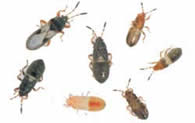 Lots of lawns took a beating last year by the bugs. The chinch bug was responsible for a lot of it. They prefer St. Augustine grass but will also feast on Bermuda, Zoysia, and Centipede grass. Chinch bugs like it hot and dry. For this reason a lot of the damage occurs next to streets, driveways and sidewalks. Grass damaged by chinch bugs remains attached to its roots unlike grub damage. Before you start spraying or spreading you’re insect killer of choice you need to identify the problem.
Lots of lawns took a beating last year by the bugs. The chinch bug was responsible for a lot of it. They prefer St. Augustine grass but will also feast on Bermuda, Zoysia, and Centipede grass. Chinch bugs like it hot and dry. For this reason a lot of the damage occurs next to streets, driveways and sidewalks. Grass damaged by chinch bugs remains attached to its roots unlike grub damage. Before you start spraying or spreading you’re insect killer of choice you need to identify the problem.
The chinch bug is a surface dwelling creature and it is easily detected. Remove the top and bottom of a steel can. Push it into the soil at the edge of the healthy and damaged grass and then fill it with water. The chinch bug will swim to the top. Then count the bugs. The attached link will provide you with the number you don’t want to see.
So, okay, you found more chinch bugs than average. Now we start to control them. All-natural products include DE (Diatomaceous Earth) or my favorite, orange oil. On the synthetic side, we like Kill-a-Bug (permethrin) and Cyonara spray (lambda-cyhalothrin).
For more information on Chinch Bugs, please click here.





